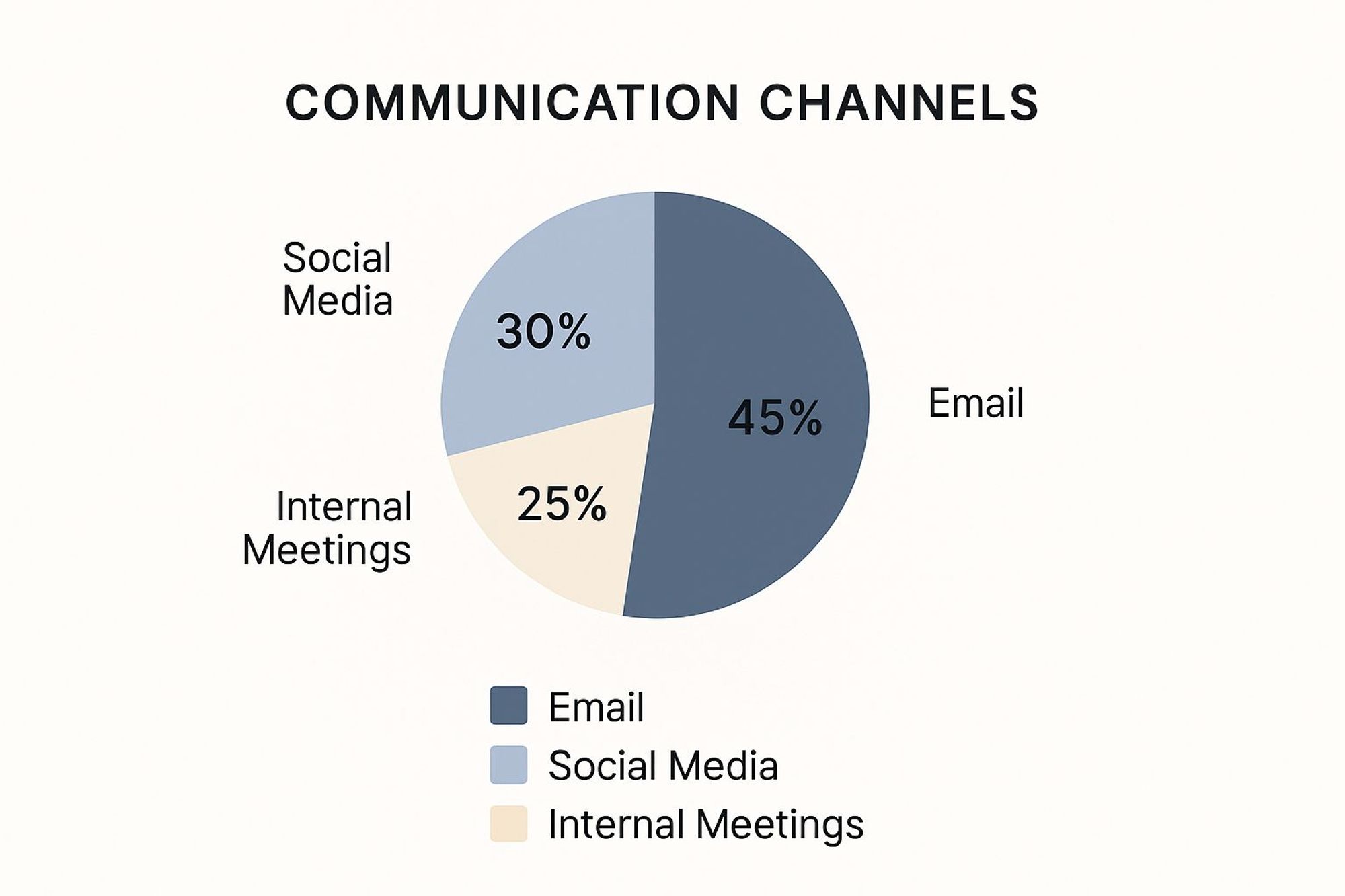Sunday, May 18, 2025
Effective Communication Strategy Template for Success

Building the Foundation: What Makes Strategies That Work
A communication strategy template isn't just a document; it’s the blueprint for your success. It provides the framework to guide your messaging, ensure consistency, and ultimately, achieve your communication goals. But a template alone isn't enough. It needs a strong foundation built on carefully considered key principles. The strategic planning phase is crucial for addressing potential problems and setting the stage for truly impactful communication.
Essential Elements of an Effective Communication Strategy
Effective strategies share core components that contribute to their success. Understanding your target audience is paramount. You need clearly defined objectives, a compelling narrative, and the right mix of communication channels. Aligning your communication strategy with your overall branding is also important. For startups, developing a solid brand is especially critical; learn more about building a branding strategy for startups. Finally, the development process itself plays a vital role.
Developing a strategic communication plan requires a deep understanding of your organization’s goals and its environment. Data-driven decisions are essential in today's business world. This involves conducting audits of current initiatives, analyzing market research, and evaluating the competition to create a solid foundation for strategic planning. For instance, data can reveal which channels are most effective for reaching your target audience. You might discover that traditional media channels are less effective than they once were, while the importance of social media platforms continues to rise. Using data insights, organizations can refine their communication strategies to keep pace with evolving market conditions and advancements in technology. You can explore this further here.
To help you develop a well-rounded strategy, let's take a look at the key components:
Introducing the following table outlining the essential elements that should be included in any comprehensive communication strategy template.
This table provides a framework for creating a robust communication strategy by considering these key components. Remember, each element plays a crucial role in ensuring your message reaches the right audience with the intended impact.
Why Strategic Planning Matters
Many organizations treat the strategic planning phase as just a formality, rushing through it to get to the implementation stage. However, this is a critical mistake. A solid strategy ensures everyone is working together towards common goals, using the most effective methods. It's like building a house: without a strong foundation, cracks and instability will inevitably appear later on.
Adapting to Different Organizational Needs
While the core principles of a communication strategy remain constant, how you apply those principles will differ. A startup may prioritize building brand awareness and attracting early adopters. A large enterprise, on the other hand, might focus on maintaining its reputation and engaging with a wider range of stakeholders. This means adapting the template to fit each organization's unique context, addressing its specific challenges and opportunities.
Avoiding Common Pitfalls
Even the best communication strategies can be derailed by common mistakes. One frequent mistake is failing to clearly define objectives. Without measurable goals, tracking progress and proving the value of your communication efforts becomes impossible. Another pitfall is neglecting audience analysis. Truly understanding your audience is essential for crafting messages that resonate and achieve their intended impact. Careful planning and a commitment to data-driven decision-making can help you avoid these pitfalls.
Creating Objectives That Drive Measurable Results

Setting clear objectives is the cornerstone of any successful communication strategy template. Instead of vague aspirations, define concrete, measurable outcomes. This ensures everyone understands the goals and how their work contributes to success. Measurable objectives also allow you to track progress, demonstrate ROI, and adapt as needed.
Defining SMART Objectives
One proven method for creating strong objectives is the SMART methodology. SMART objectives are Specific, Measurable, Achievable, Relevant, and Time-bound. For instance, instead of "improve brand awareness," a SMART objective could be "increase website traffic by 15% next quarter." This focused, measurable, and time-constrained goal provides a clear target and enables accurate tracking.
Aligning Communication Objectives with Organizational Priorities
Communication objectives should always support overarching organizational goals. This alignment ensures that communication contributes to the business's overall success. It also makes it easier to secure leadership support and necessary resources. For example, if a company wants to expand into a new market, a related communication objective could be "generate 500 qualified leads in the target market within six months."
Avoiding Common Mistakes in Setting Objectives
Many communication objectives fail because they are poorly defined or lack a connection to business impact. One common error is setting objectives that are too broad or lack specific metrics, making it difficult to measure success. Another mistake is failing to align communication objectives with organizational priorities, potentially leading to wasted effort and resources.
From Challenges to Actionable Objectives
Turning communication challenges into effective objectives requires thoughtful analysis and strategic thinking. Perhaps you're dealing with low employee engagement. A corresponding objective could be to "increase employee participation in internal communication channels by 20% within the next year." This action-oriented objective provides a clear direction and a way to measure improvement. Check out this helpful resource: How to master your social media content calendar.
Case Study: Internal Communication Improvement
A company struggling with low employee morale set a SMART objective to boost employee satisfaction scores by 10% within six months. They implemented a comprehensive communication strategy featuring regular town halls, enhanced newsletters, and a feedback platform. Tracking satisfaction scores over time demonstrated the positive impact of their efforts, helping them secure resources for future initiatives. This success story shows the importance of well-defined objectives in achieving meaningful results.
Audience Analysis: Going Beyond Basic Demographics

A communication strategy template is only as effective as its underlying audience understanding. Many strategies fall short because they target broad demographics instead of exploring the specific needs and motivations of their target audience. This surface-level approach results in generic messaging that fails to resonate. Truly effective communication necessitates a much deeper understanding. It requires grasping the why behind audience behaviors, not just the what.
Understanding Your Audience's Motivations
Going beyond basic demographics means understanding what truly drives your audience. What are their goals, values, and pain points? For example, when marketing a new software product, knowing your audience's age and location is helpful. However, understanding their frustrations with existing software and their desire for increased efficiency is paramount. This deeper understanding allows you to craft communications that directly address these needs. Read also: How to master your audience engagement strategies.
Building Comprehensive Audience Personas
Audience personas are fictional, yet detailed, representations of your ideal customer. They go beyond simple demographics to encompass psychographics, behaviors, and motivations. Constructing comprehensive personas involves gathering data from multiple sources, including surveys, interviews, and social listening. These personas become invaluable tools for crafting targeted messages that resonate deeply with your audience.
Gathering Meaningful Audience Intelligence
Effective audience analysis doesn't have to be costly. Practical approaches, like social listening, offer valuable insights into audience conversations and sentiment. Analyzing website analytics through tools like Google Analytics reveals which content resonates with visitors and what their interests are. Qualitative research methods, such as focus groups or interviews, provide deeper insights into audience perceptions and motivations. Crafting a communication strategy involves several key elements, including audience engagement, communication channels, and risk tolerance. As of 2025, trends such as AI-enhanced interactions are shaping how businesses communicate. For instance, AI tools are increasingly integrated into strategies to improve customer service and personalization. Learn more about 2025 communication strategies.
Mapping the Audience Journey
Understanding the audience journey—the steps a person takes from initial awareness to becoming a customer—is crucial. Mapping this journey helps you identify key touchpoints and tailor your communication accordingly. For example, you might use social media for awareness, email marketing to nurture leads, and personalized website content to convert prospects. This strategic approach ensures the right message reaches the right person at the right time.
Prioritizing Stakeholder Groups
Not all audience members are equally important. Some stakeholders wield more influence or hold greater strategic importance than others. Prioritizing these key groups allows you to focus resources where they’ll have the greatest impact. This could involve developing tailored communication plans for key influencers or creating specific content addressing particular stakeholder concerns. This focused approach maximizes your communication efforts, ensuring you connect effectively with the most important audiences.
Messaging Architecture: Building Narratives That Resonate

A strong communication strategy template requires a well-defined messaging architecture. This involves creating narratives that truly connect with your target audience and ultimately drive desired results. Just as an architect designs a building with structural integrity, a communication expert crafts a message framework delivering a consistent and compelling narrative.
This ensures clarity, strengthens your brand, and helps achieve communication goals.
Developing Message Hierarchies
Effective messaging hinges on a hierarchical structure. This means identifying core messages and supporting points that build upon one another. Think of it as an inverted pyramid: the most important message sits at the top, supported by increasingly specific details.
This ensures that even if audiences only absorb the high-level message, they still grasp the key takeaway. It also allows for nuanced communication tailored to different audience segments and their unique information needs.
Testing Message Effectiveness
Testing message effectiveness is essential before widespread deployment. Methods include focus groups, A/B testing different message versions, or simply gathering feedback from colleagues.
Testing helps identify potential issues early, preventing costly mistakes. A message that seems clear to you might confuse your target audience. Testing offers invaluable insights and helps refine messaging for maximum impact.
Adapting Messages Across Channels
Consistency is key, but your core message may require adaptation for different channels. A concise message perfect for Twitter might need expansion for a blog post. Maintaining a core narrative across these versions is crucial for brand coherence and audience understanding.
This means retaining the central idea and key supporting points while adjusting the format and language to suit the platform.
Utilizing a Message Matrix
A message matrix is a powerful tool for aligning specific audience segments with tailored messaging. It ensures diverse audience segments receive relevant information while maintaining a consistent brand voice.
This structured approach mitigates the risk of confusing your audience with conflicting or irrelevant messages.
Navigating Sensitive Topics and Competing Perspectives
Certain communication topics demand careful handling, especially sensitive issues or internal disagreements about messaging priorities. A communication strategy template can provide a framework for these situations.
It can outline best practices for transparent communication and ethical considerations. This ensures responsible messaging that avoids unintentionally alienating or offending any stakeholder group. Learn more about managing content with our content management best practices playbook.
Channel Strategy: Matching Mediums to Messages
Choosing the right communication channels is crucial for any successful communication strategy. It's not just about selecting the most popular platforms, but about strategically aligning your message with the best medium for maximum impact. This requires a keen understanding of your audience's preferences, the complexity of the message, and your organization's resources.
Matching Channels to Communication Objectives
Different channels are better suited for different objectives. For instance, social media excels at building brand awareness and generating buzz around new products or campaigns. Email, on the other hand, remains a highly effective method for delivering detailed information, nurturing leads, and sharing important updates. Internal meetings are indispensable for in-depth discussions, team building, and collaborative problem-solving. The infographic below illustrates a typical distribution of communication channels and underscores the need for a balanced approach.

As the infographic demonstrates, email continues to play a dominant role, representing nearly half of all communication activities. While social media and internal meetings also occupy significant portions, the prevalence of email reinforces its continued importance in a well-rounded communication strategy.
One critical factor to consider is channel effectiveness. Studies reveal that in 2025, 92% of employers relied on email, achieving an 89% effectiveness rate for information dissemination. Company-wide live events, although utilized less frequently (78%), demonstrated an impressive 97% effectiveness rate. For a deeper dive into these statistics, see more here. These findings emphasize the importance of selecting channels based on their strengths and suitability for specific goals.
To further illustrate the effectiveness of different channels, consider the following table:
Communication Channel Effectiveness Comparison
This table compares different communication channels based on their effectiveness for various communication objectives.
This table highlights the diverse strengths and weaknesses of different channels. While email excels in reach and cost-effectiveness, live events offer higher impact but require greater resources. Social media offers the potential for broad engagement but necessitates continuous management and analysis.
Developing an Integrated Multi-Channel Approach
A truly successful communication strategy often involves a combination of channels working in concert. This integrated approach reinforces key messages across multiple touchpoints, ensuring consistent communication and maximizing audience reach. However, avoid information overload. Carefully coordinate your messaging across all platforms to create a cohesive, yet manageable, experience for your audience.
Balancing Innovation and Proven Effectiveness
While exploring new and emerging communication channels is important, don’t abandon proven methods. Email, despite the rise of newer platforms, remains a powerful communication tool. Balancing innovation with proven strategies ensures a dynamic yet reliable approach. This might involve integrating emerging platforms like Threads or Bluesky alongside established channels like email and LinkedIn, creating a diverse communication mix with wider reach.
Adapting Content Across Channels
Tailoring content to specific channels is critical. What resonates on Twitter may not be appropriate for LinkedIn or an internal newsletter. Adjust your message to fit each platform’s format and audience expectations. Concise messaging works well for social media, while long-form content thrives in blog posts or email newsletters. Maintaining consistent core messaging while adapting the format and tone ensures clarity and reinforces your narrative.
Measuring Channel Performance
Measuring channel performance is crucial for optimizing your communication mix. Track metrics like open rates, click-through rates, and engagement levels to understand what’s working and what needs improvement. Regularly analyze this data to refine your strategy, allocate resources effectively, and keep your approach aligned with your objectives. Utilize tools like Google Analytics and social media analytics dashboards to gain valuable insights into audience behavior and channel effectiveness. This data-driven approach helps you continuously improve your communication strategy and maximize its overall impact.
Implementation Planning: From Strategy to Action
https://www.youtube.com/embed/JnttyHx-sTQ
A well-defined communication strategy is only as good as its implementation. This means turning plans into concrete actions that achieve measurable results. It's the point where strategy meets execution. It requires developing practical timelines, allocating resources effectively, and ensuring clear communication throughout the entire process. Think of it as bringing your strategic blueprint to life.
Developing Realistic Timelines
A realistic timeline is the cornerstone of effective implementation. This starts by outlining all necessary tasks, estimating the time required for each, and arranging them in a logical order. It's important to account for dependencies and real-world limitations that could impact the schedule. For example, a product marketing campaign launch might rely on finishing product development and getting the necessary approvals. Considering these dependencies helps avoid unrealistic deadlines and prevents potential delays.
Resource Allocation for Maximum Impact
Strategic resource allocation is crucial to prevent overworking teams and maximize the impact of your efforts. Identify the resources needed for each task—people, budget, and tools—and allocate them strategically. This might involve assigning team members to manage specific communication channels or dedicating a portion of the budget to content creation and social media advertising. Prioritize the tasks that most directly contribute to your objectives, making sure resources align with your overall strategic goals.
Sequencing Activities for Momentum
Sequencing activities strategically can create momentum and capitalize on initial wins. Start with high-impact, easily attainable tasks to show quick progress and build team confidence. For example, when rolling out a new internal communications platform, begin by introducing it to a small pilot group and gathering their feedback. This approach allows you to resolve any initial issues and ensure a smoother launch for the rest of the organization.
Collaborative Tools and Workflow Management
Collaborative tools can significantly improve how teams manage their workflow, particularly for teams working across different departments. Platforms like Asana and Trello centralize task management, file sharing, and progress tracking. This keeps everyone aligned and informed. The improved transparency and shared access streamlines communication, minimizes misunderstandings, and increases overall efficiency.
Agile Implementation: Adapting to Change
An agile implementation plan allows you to adapt to unforeseen opportunities or challenges without losing sight of your strategic objectives. Build flexibility into your timelines and resource allocation to account for potential changes. For instance, if a competitor unexpectedly launches a similar product, you might need to adjust your messaging or channel strategy. The ability to adapt quickly while staying true to your overarching goals is essential in today’s marketplace. Learn more in our article about how to master content management best practices.
Managing Stakeholder Expectations
Keeping stakeholders informed about progress and potential obstacles is critical. This involves setting clear expectations from the outset and providing regular updates throughout the implementation phase. Transparent communication builds trust and ensures that everyone remains aligned with the strategy. It also helps manage potential concerns or resistance, creating a more collaborative environment for problem-solving.
Maintaining Team Alignment
Regular communication keeps your team aligned and motivated. Regular team meetings, progress reports, and feedback sessions ensure everyone is on the same page and working towards shared goals. This ongoing interaction builds a sense of shared purpose and encourages collaborative problem-solving, which are essential for successful implementation. Celebrating milestones, both large and small, helps boost morale and maintain momentum.
Measurement Frameworks That Prove Communication Value
Moving beyond superficial metrics like likes and shares is essential for showcasing the real impact of your communication strategy. Savvy communicators know that demonstrating ROI means linking communication efforts to tangible business results. This involves establishing Key Performance Indicators (KPIs) that directly align with your communication strategy's objectives. For practical guidance on implementing communication strategies, consider using an outreach strategy template.
Establishing Meaningful KPIs
Your KPIs should be customized to your specific communication goals. If you're aiming to boost brand awareness, you might track metrics like website traffic, social media mentions, and media coverage.
But if your objective is to drive sales, your focus should shift to metrics like lead generation, conversion rates, and customer acquisition cost. The core principle is to select KPIs that directly reflect how your communication efforts influence business objectives.
Building Actionable Measurement Dashboards
A measurement dashboard provides a consolidated overview of your KPIs, enabling you to monitor progress and pinpoint areas for improvement. This dashboard should go beyond simply presenting data; it should offer actionable insights.
For instance, tracking website traffic alongside conversion rates reveals which channels are generating the most valuable leads. Armed with this knowledge, you can refine your channel strategy and allocate resources more strategically. Learn more about analyzing social media data in this article: How to master Threads analytics.
Quantitative and Qualitative Evaluation Methods
A robust measurement framework integrates both quantitative and qualitative data. Quantitative data, such as website analytics and sales figures, offers objective performance measures. Qualitative data, gathered through surveys, interviews, and focus groups, provides deeper insights into audience perceptions, motivations, and behaviors.
By combining these two approaches, you gain a more comprehensive understanding of your communication strategy's impact.
Conducting Meaningful Communication Audits
Regular communication audits are instrumental in identifying areas for continuous improvement. These audits involve examining every facet of your communication, from messaging and channel strategy to execution and measurement.
The purpose is to evaluate the effectiveness of your current approach, identify any gaps or weaknesses, and implement data-driven adjustments. This ongoing evaluation and refinement process ensures your communication strategy remains relevant, impactful, and aligned with your goals.
Demonstrating Communication ROI to Leadership
Communicating the value of your work to leadership involves translating communication activities into business outcomes they understand. Focus on showcasing how your efforts have contributed to key organizational objectives, such as increased sales, improved customer satisfaction, or a stronger brand reputation.
Use clear, concise language, backed by data from your measurement dashboard, to present a compelling narrative of your communication strategy's value.
Measurement on a Limited Budget
Even with limited resources, effective communication measurement is possible. Free tools like Google Analytics provide valuable website data, while social media platforms offer built-in analytics dashboards.
Consider conducting small-scale surveys or interviews to gather qualitative insights. By focusing on a few key metrics and using readily available resources, you can demonstrate the impact of your communication strategy even on a tight budget.
Ready to elevate your social media strategy? Schedul empowers you to plan, automate, and scale your social media presence efficiently. Start your free trial with Schedul now!
No credit card required!